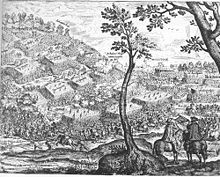Cürassier Regiment Jung-Nassau
The Cürassier Regiment Jung-Nassau was a cavalry unit of the Imperial Habsburg army. The first regiment owner and commanding officer was the then Colonel Duke Franz Albrecht von Sachsen-Lauenburg .
The regiment was called "Young Nassau" because there was a second Nassau regiment, it was the regiment of Colonel Ludwig Heinrich von Nassau-Dillenburg and was called "Old Nassau".
Formation history
- With a patent dated June 4, 1625 the regiment was set up in Saxony .
- In 1632 the unit was reinforced with two companies of the "reduced" (downsized) "Regiment Haagen". New recruits were also made this year.
- 1649: The regiment was first reduced and then disbanded.
Regimental owner
- 1624: Colonel Duke Franz Albrecht of Saxony-Lauenburg
- 1632: Colonel / Feldzeugmeister Melchior von Hatzfeld
- 1642: Unclear. A colonel, Count Christian von Nassau-Hadamar, is mentioned, but does not appear in the Nassau family tree.
- 1644: General Field Sergeant / Field Marshal Lieutenant Count Raimondo Montecuccoli
- 1645: Field Marshal Melchior von Hatzfeld , Count von Gleichen
- 1647: Colonel Johann von Mortal
- 1647: Colonel Prince Moritz Heinrich von Nassau-Hadamar
Regimental Commanders
- 1625: the owner, Colonel Duke of Saxony-Lauenburg
- 1629: Lieutenant Colonel Melchior von Hatzfeld
- 1632: The owner, Colonel Melchior von Hatzfeld
- 1635: Lieutenant Colonel Adolph Krafft
- 1636: Lieutenant Colonel Fingerling
- 1642: Unclear. (see above)
- 1645: Lieutenant Colonel Franz Schneider
- 1646: Lieutenant Colonel / Colonel Johann von Mortal
- 1648: Lieutenant Colonel Count Siegfried Hohenlohe
Battle calendar
- 1626: After the battle of the Dessau Brück, the regiment moved to Hungary
- 1627: Campaign under Wallenstein in Northern Germany
- 1628: Combat in the Reich, in Pomerania and in Poland
- 1629 - 1630: Fighting with distinction in Italy near Mantua . The emperor presented the owner with a "thank you letter".
- 1631: The regiment returned to Germany with the army of Generalfeldzeugmeister Graf Fürstenberg and fought in the Battle of Breitenfeld
- 1632: Under the command of General Graf Pappenheim , the regiment arrived on the battlefield near Lützen in the evening and therefore too late.
- 1633: assigned to the Corps Holcke, without any particular combat activity
- 1634: Participation in the battle of Liegnitz
- 1635: The regiment was on the Upper Rhine.
- 1636: Siege of Magdeburg and battle near Wittstock
- 1637: Battle near Pegau
- 1638: Battle of Vlotho
- 1639: Relocation to the main army in Bohemia
- 1640: Battles near Plauen and Ziegenhain
- 1641: Battles near Wolfenbüttel
- 1642: Relocation to the Jülich Fortress .
- 1643: Skirmish with Hessian troops between Düren and Neuss
- 1644: March to Franconia to reinforce Hatzfeld's corps.
- 1645: March to Bohemia and participation in the battle of Jankau . Relocation to Franconia in the same year. Battle of Herbsthausen
- 1646: The regiment was in Bavaria without any major actions
- 1648: Fighting in the battle of Zusmarshausen , part of the regiment fought in the battle of Frauenberg.
- 1649: With the army reduction as a result of the Peace of Westphalia , 30 of the 39 cuirassier regiments were abdicated (dissolved) with the imperial resolution of March 11, 1649.
Fallen senior officers
The regimental commander, whose identity cannot be established, fell in 1643 in a battle with Hessian troops between Düren and Neuss.
literature
- Alphons Freiherr von Wrede “History of the Austro-Hungarian Wehrmacht III. Volume “Verlag Seidel & Sohn - Vienna 1901

